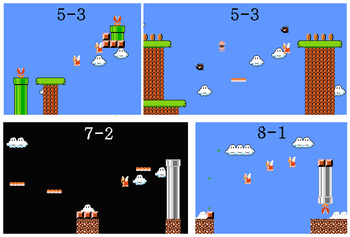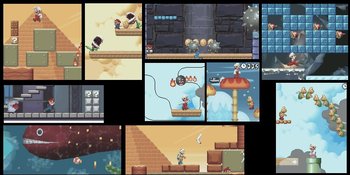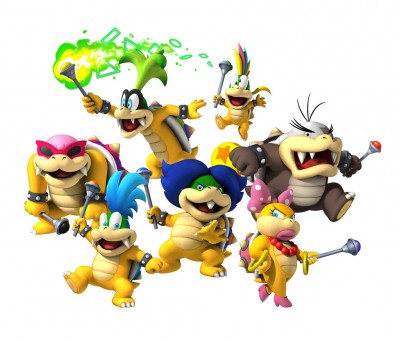ENEMIES
Mario's gameplay is designed around timing jumps. But simply JUMPing over pipes and pits can only be interesting for so long. To solve this problem every Mario game features enemy elements. Enemies not only force players to maneuver around them, but the way they move through space creates organic timers. This is especially important to undertand. If the obstacles the player must time JUMPs to progress communicate their timing visually, the player doesn't have to memorize how to get through levels. Instead, the player can just read the screen. Throw in a little interplay to the enemy design, and the variety of timing based challenges increases substantially. This is the essence of Mario's core counterpoint design.
The enemies in the Super Mario Brothers games are each designed to take up a unique, functional design space. In other words, there's no enemy element that completely overlaps a Goomba in function (or any other enemy for that matter). Each enemy is different from each other, and even the smallest difference can contribute to very different gameplay scenarios because of emergence.
In our investigation of Mario enemies we must consider an enemy element's function, arrangement in levels, and how it contributes to the counterpoint of the core gameplay experience. Let's start at the beginning.

This game started it all. The excellently design SMB enemies can be found throughout nearly every Mario game. The genius of the enemy design in SMB is in its simplicity. Most of the enemies move at a constant speed in a predictable fashion. In other words, most enemy elements don't have any AI or randomized actions of any kind. The Lakitu and Bloopers are slightly more complicated in that they follow the player around. Also, the Hammer Brothers and Bowser have randomized patterns and/or complex timers that make predicting their movements much harder. But the vast majority of the enemies in the game are simple ones.
Because of how Mario, level elements, and enemies are all designed to react off of each other, what appears to be a straightforward level section can be designed to teach players through their emergent actions. In the Iwata Asks series on New Super Mario Brothers Wii, Shigeru Miyamoto describes how the intro to World 1-1 works on an emergent level. This example shows us that we must always think of Mario's challenges and level design in layers that come together in emergent ways.

- The enemies of SMB are designed with a considerable amount of simple interplay. Read more about it here.
- The enemies in the game include, Goomba, Koopa Troopa, Paratroopa, Piranha Plant, Spiny, Buzzy Beetle, Lakitu, Cheep Cheep, Blooper, Bullet Bill, Hammer Bros., Fire Balls, and Fire Chains.
Bosses
- The boss battles are challenging and quick. Instead of engaging in long drawn out battles where the player must wait for a boss to repeatedly reveal its weak spot and then hit that spot anywhere from 2 to hundreds of times like in other games, players can end Bowser battles as quickly as they can reach the axe. In these battles, powerups really make a difference. Fire flower Mario can kill Bowser with fireballs. Big Mario can simply RUN straight through Bowser and take the hit. But for Small Mario, death is one mistake away. High risk. High reward. Clear goal.

SMB:LL was made with all of the existing enemies from SMB. The closest SMB:LL comes to a new enemy is a flying Blooper. In general, the enemy arrangement in SMB:LL is designed to make challenges more difficult.
- Trickier enemy arrangements. Compared to SMB, more pipes in SMB:LL have Piranha Plants inside. Buzzy Beetles and Koopa Shells are positioned in tight areas or near walls so the shells can bounce back at the player. Also, because the platforms and structures are smaller, the player has less maneuvering options when avoiding enemies.
- Many enemies. On average, the levels in SMB:LL feature more enemies than the levels in SMB. These levels have a particularly large number of enemies (many with over 40!); 2-2, 2-3, 3-2, 4-4, 5-1.

- Enemy platforms. SMB:LL features some enemies that function as mandatory platforms for progression (5-3, 7-2, 8-1 see image above).
- Unexpected enemies. The Poison Mushroom looks like a powerup, but it's really an enemy. Touching it from any side is the same as getting hurt by an Koopa. Also, enemies are put in several bonus rooms. You're rarely safe from danger in this game.
Bosses
- The Bowser boss battles are about the same as in SMB. In SMB:LL Bowser acts more aggressively leading up to the confrontation by shooting more fire. Finally, most of the boss room structures have different brick arrangements.

SMB2 is the Mario game in this study that is the least like the others. This comes as no surprise to those who know this game's history. Beside a host of new enemies, there are many design features in SMB2's enemy design that hold the game back from developing a level of deep interactivity that the other Mario games have.
- Stop and go interactivity. JUMPing on enemies isn't enough to dispense with enemies in this game. To get rid of enemies, they must be GRABbed and thrown into other enemies or into pits. This basic design puts a stop or hiccup in the flow action when players seek to kill enemies.
- Knockback. SMB2 is the only 2D Mario platformer with knockback (getting pushed to the side after getting hurt). Instead of being able to take a hit and continue moving through the game, the flow of the action has this hiccup.
- Faster movement. The enemies in SMB2 move more quickly than enemies in SMB. This design makes it harder to land on top of enemies, harder to aim throws, and harder for the player to play around the layered gameplay.
- Sub-mar interplay. Sub-mar is a coined term that essentially means less than the design level put into SMB, and it applies to the interplay design of SMB2's enemies. SMB2 enemies don't...
- bump into each other and turn around.
- rebound the player back into a JUMP.
- introduce an element of danger back on the player (bouncing Koopa shell).
- delay shooting projectiles when the player moves in close (Bullet Bill shooters/Piranha Plants).
- Crowding enemy elements. There are times in SMB2 when the screen is filled with many enemies that are all influencing the player in about the same way thus overcrowding each other in function. Like in Geometry Wars, the high volume of enemies doesn't necessarily make the game more interesting or challenging. In these cases, it makes the game more cluttered.
- Complex patterns. While a few enemies in SMB have more complex patterns, many of the enemies in SMB2 have patterns that are even more complex. Though mixups are one interesting way of making an enemy more challenging, too many mixups can shift the balance of the game away from the player understanding all the risks of an encounter to the player having to guess more than strategize. Some SMB2 enemies..
- turn around to chase the player sporadically
- jump sporadically
- shoot sporadically
- SMB2 enemies include Shy Guys, Tweeter, Snifit, Ninji, Beezo, Hoopster, Phanto, Trouter, Ostro, Bob-Omb, Albatoss, Pidget, Cobrat, Panser, Porcupo, Pokey, Autobomb, Flurry, Spark
Bosses (video)
- All of the bosses are pretty distinct from each other. Their design drives home the fact that SMB2's primary function is split between JUMPing and throwing objects. JUMPing on the heads of these bosses won't do you any good. At least there's egg to egg (Birdo), rock to rock (Clawgrip), and vegetable to bubble (Wart) interplay that emphasises taking careful aim. Also, the small mushroom like structures can be used to build walls to trap enemies or as a shield from attacks.
- Birdo, Mouser, Fryguy, Tryclyde, Clawgirp, and Wart.

SMB3 takes all of the enemies from SMB and only one from SMB2 (Bob-Omb).
- Slow and Steady. From cannon balls, fireballs, to wrenches most of the enemy elements in SMB3 move slowly across the screen. Slower enemy elements deemphasize quick reaction times while emphasizing layered timing, challenges, and reactive interplay.
- Custom Enemies. More so than the previous Mario games, SMB3 enemies are designed and paired with game ideas for specific levels. This should become clear when you realize that you've only seen some enemies in only one or a few levels.
- Simpler enemies. Compared to the SMB enemies, some the SMB3 enemies have been simplified. For example, the Hammer Bros. jump on a predictable timer and throw fewer hammers that are easier to dodge.
- Less is more. To create a high level of engaging gameplay, SMB3 relies on fewer enemies, but they layer well together. Also, with hills and other new platforms/structures, there's more than enough to work with to keep things interesting and fresh.
- The Hot Foot, Fire Chomp, Paragoomba, Venus Fire Traps, Walking Piranha, Lakitu, and Spike have more complex and/or less predictable actions.
Bosses (video)
- Boom-Boom is the mini boss at the end of every mini fortress. It has different mixups depending on how many hits you give it.
- Stage 1 (no hits). Boom-Boom will sporadically dance back and forth making it much harder to land on its head than a Goomba. It will also retreat into its shell to the musical cues.
- Stage 2 (1 hit). Boom-Boom will either jump back and forth around the stage or fly around the stage for a swooping attack. With either option, Boom-Boom ignores the musical cues.
- Stage 3 (2 hits). Boom-Boom attempts to finish the fight by rushing Mario down. By moving back and forth more quickly, his sporadic directional changes become even deadlier. Fortunately, you never have to let things get this difficult. By timing your JUMPs correctly, you can kill this boss in a 3 quick hits without ever letting him set up these mixups.
- Stage 1 (no hits). Boom-Boom will sporadically dance back and forth making it much harder to land on its head than a Goomba. It will also retreat into its shell to the musical cues.
- The Koopa Kids all vary in their attack patterns and stage platform arrangement. After each hit, the Kids retreat into their shells for a brief period of time and move around the stage. They are invulnerable in their shells. Like Boom-Boom if you let them get going they can trap you with their mixups. Otherwise, they can be finished off quickly with 3 JUMPs.
- The final Bowser boss battle involves luring Bower to smash down on bricks beneath you. If he smashes enough bricks, he'll fall down into the lava. This battle takes a bit of time to win. All the while, Bowser will launch fireballs as a part of his mixup game. As players trick Bowser into working away the floor, the terrain and therefore the platforming challenge changes. This design makes the battle dynamic and interesting the whole way through.

SMW takes all the enemies from SMB, some from SMB2 (Pokey, Ninji), and some from SMB3 (Bob-Omb, Boos, Dry Bones, Paragoomba, and Thwomp). The enemy design of SMW is closer to SMB2 than any other 2D Mario platformer. Compared to SMB3, the enemies move quickly and have comparatively complex patterns/AI. Full list here. Also, enemies can attack in great numbers at once compared to the numbers in SMB or SMB3. For these reasons the layered counterpoint of SMW isn't as rich as SMB or SMB3. Furthermore, SMW features one core mechanic that puts a strain on the entire enemy design.
- Undermining SPIN JUMP. (video). This mechanic allows players to safely JUMP off of dangerous enemy elements. From buzz saws to fire balls, by SPIN JUMPING players can use these enemies like a spring pad. With this design, it becomes harder to design levels that limit and trap players with intersecting contrary elements.
- For example, Koopa and other enemies can be killed with the SPIN JUMP. In SMB, a Koopa or a Buzzy Beetle can set up a dangerous trap when trapped between two walls. In SMW, because the enemy can be eliminated, this trap is less effective.
Bosses
- Renzor is a nice, simple boss that can be defeated as quickly as you're able to hit all 4 dinosaurs from underneath.
- The Koopa Kids return and are very similar to their SMB3 incarnations. Lemmy Koopa plays a bit of a mixup game by poking out of a series of pipes, but he still can be defeated very quickly.
Ask yourself if this battle is very interesting to watch.
- The final Bowser battle in SMW is much weaker in design than the SMB3 and SMB final Bowser boss battles. Instead of focusing on using the primary mechanic JUMP to platform around and aim landings, you defeat this Bowser by kicking Mecha-Koopa enemies at him. Not only are players forced to use this tertiary mechanic to do damage, but players are supplied Mecha-Koopa by the game/Bowser. After the Koopa are used up to hit Bowser, players have to wait and dodge around until Bowser feels like forking over more Mecha-Koopa. This design pits players against the set piece as opposed to the boss itself. In other words, players sort of play along with the scenario. When Bowser isn't on the screen or there's nothing to hit him with, you're practically waiting for the battle/game to resume.

The enemy design and arrangement of NSMB follows the trend of SMB3 rather than SMW. Levels are differentiated by unique game ideas, platforms/structures, and by using unique enemies. And like SM3, less is more. NSMB uses a small number of interesting enemies (based on movement patterns and interplay) to develop a rich layered counterpoint. The follow are what NSMB adds to the enemy design of the 2D Mario platformers.
 Most of the encounters feature very few enemies
Most of the encounters feature very few enemies
- Small tweaks to enemy interplay and behavior. Bob-ombs can be ignited and pushed around with fire balls. STOMPing bosses does more damage than JUMPing on them. STOMPing on Koopa automatically kicks their shells horizontally. JUMPing on Mega Bones only temporarily stuns them while STOMPing them breaks them apart. Enemies like Broozer and Skeeter can destroy bricks and platforms that the player cannot break.
- Small tweaks to enemy behavior. Enemies dance or react to specific musical cues. Goomba hop. Koopa side step. Spiny flip directions.
Bosses
- Bowser Jr. These battles like a mix between the Boom-Boom battle of SMB3 and the Koopa Kid battles of SMB3 and SMW. As players progress through the game, they fight many versions of Bowser Jr. Each version is slightly different. Some stages have moving parts or are made of ice. Some Bowser Jr. run straight for the player while others retreat into their shell when Mario draws near. Others still spin around inside their shell after getting hit.
- All of the other bosses in the game are very unique, fairly simple, and quick to defeat. None of the bosses are as quick as the SMB's Bowser or SMB3's Boom-Boom, but they're quick nonetheless. Bowser, Mummipokey, Cheepskipper, Mega Goomba, Petey Piranha, Monty Tank, Lakithunder, Bowser (Skeleton), Bowser Jr. & Bowser

With the expanded screen size the developers of NSMBWii had a lot of freedom with enemy design. Like a proper sequel, NSMBWii takes the best elements of enemy design and/or arrangement from all the other Mario games. NSMBWii...
- takes the foundation of enemy design from SMB.
- takes the less is more philosophy for enemy numbers from SMB3 and NSMB.
- designs custom enemies for specific worlds and game ideas (SMB3/NSMB).
- arranges many enemies in small spaces like in SMW and SMB2.
- positions enemies in places that are very difficult for the player to counter (SMB:LL).
- makes small tweaks to the interplay of its enemies.
- Bullet Bills slow down when traveling through water
- Bullet Bills slide off of each other in head on collisions
- frozen enemies float in water
- frozen enemies hover in mid air as platforms before dropping
- freed Chain Chomp can crash through bricks and hurt players.
- makes small tweaks to enemy behaviour (NSMB)
- Enemies dance or otherwise react to specific musical cues.
Of course, "less is more" and "many enemies in small places" are two contradictory ideas. To clarify, all of these trends are reflected in some NSMBWii levels but not necessarily in each level simultaneously.

- The Bowser Jr. and the Koopa Kids design is closest to SMB3 Koopa Kids. Three JUMPs to the head will do them in. With every hit the bosses generally get harder. However, if you play very aggressively, you can defeat the bosses before they can set up their harder challenges or mixups. Instead of a simple and repetitive Boom-Boom boss as the mini boss of each world, NSMBWii pits you against each Koopa Kid twice with the second encounter being more difficult/layered than the first.
- Increased interplay.
- Unlike in SMB3, hitting these bosses with 6 fireballs equal one JUMP hit. So, even if you have the Fire Flower powerups, you still have to go through all 3 stages of the boss.
- The energy projectiles the bosses launch block fireballs.
- Lemmy's bouncing balls push Mario around instead of just hurting him like in SMB3.
The flip side to enemy elements that are designed to challenge, threaten, and harm the player, are positive elements. Mario is a richer man for the coins he collects and Mario's gameplay is a richer, more well-rounded experience because of coins; the topic of the next part in this series.